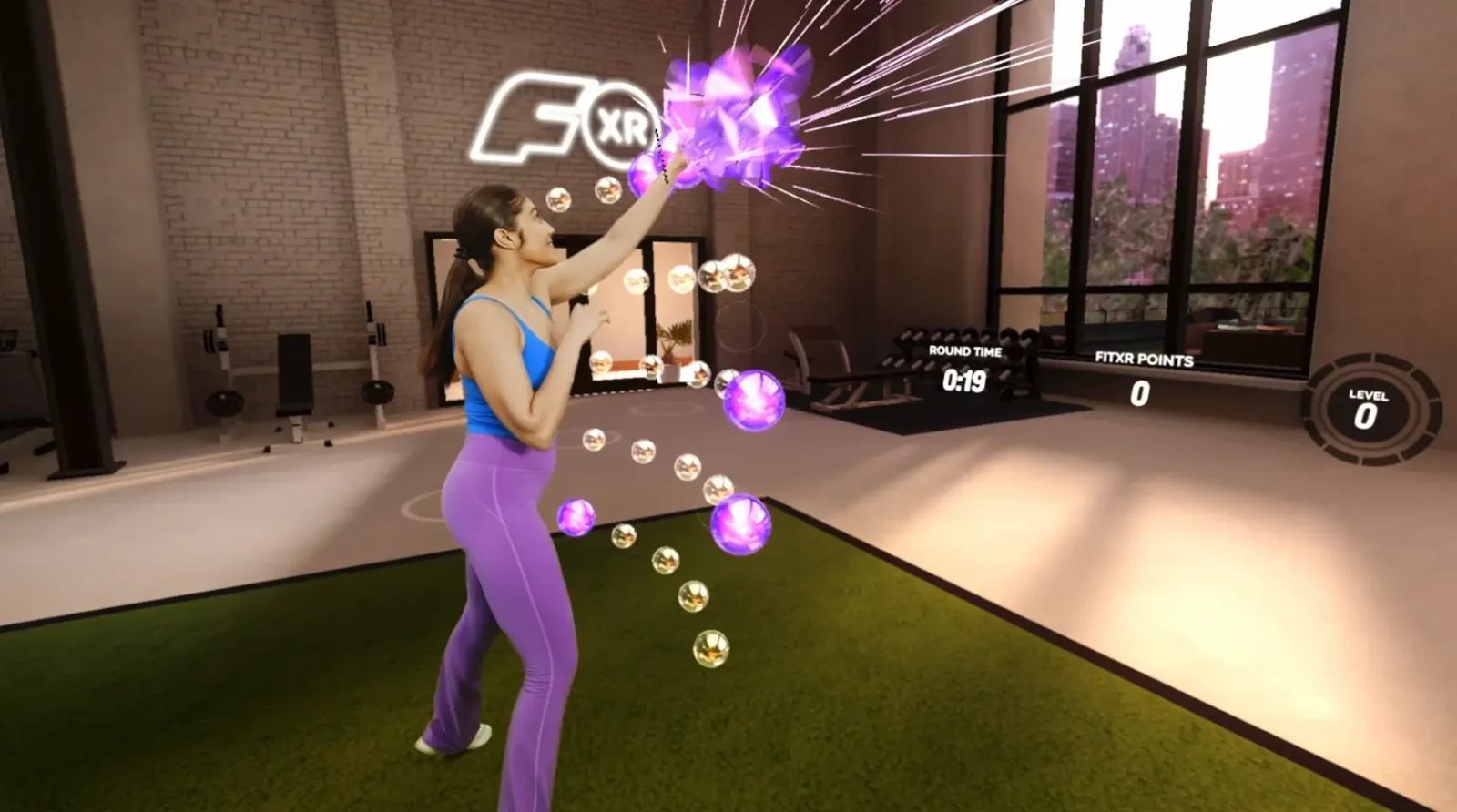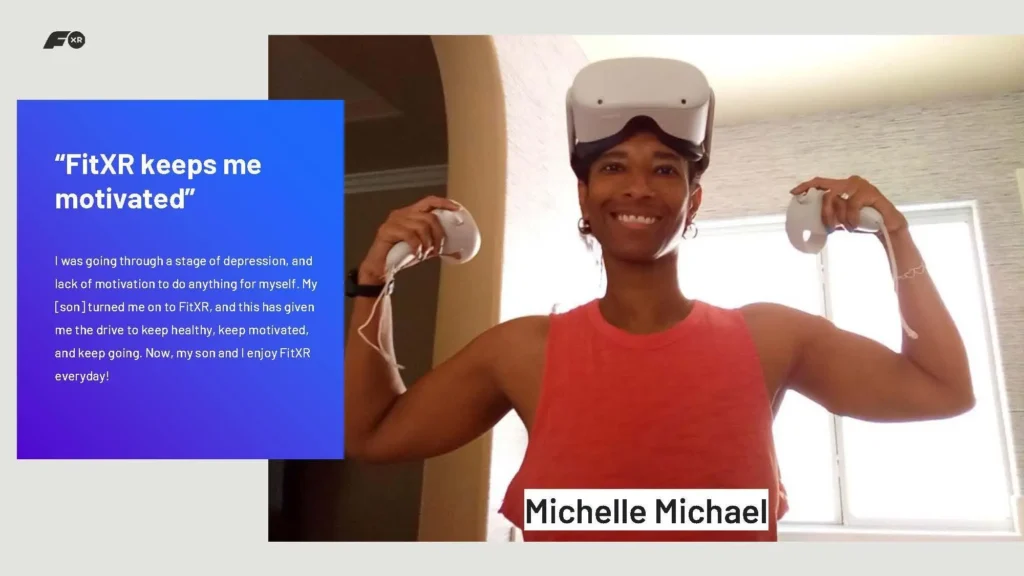The Future of Fitness? FitXR’s Mission To Get People Off the Couch

Sam Cole, founder of the popular FitXR app, spoke with Athletech News about why Extended Reality is changing the workout game
Sam Cole didn’t have to think about exercise very much when he was growing up playing sports in New Zealand. For him, being active was a byproduct of getting into the flow of competitive team athletics.
It wasn’t until after he stopped playing rugby post-university that the FitXR founder and CEO had to find other ways of keeping fit. He found that boutique group fitness classes offered a great way to get into what he calls a “flow-like state,” in which the experience is so immersive that he forgets he’s working out.
He began to think about the different elements of high-quality group fitness – a great instructor, engaging environment, motivating music and the opportunity to synchronously work out with other people – and how it could be delivered in a new way to more people.
“When we launched FitXR in 2016, many in the industry were talking about immersive fitness, but not in connection with VR headsets, which were still associated with video gamers. I thought a lot about how to combine a great soundtrack, great lighting effects, a great instructor and great environment. What’s the next thing we could do? We could bring in the visual layer. I kind of merged these two thoughts in my head and was pretty sure you could deliver an amazing experience helping people to get into a flow-like state around exercise via a virtual reality headset.”

Cole and his partners carried the core belief that immersive fitness would get people into a flow-like state into its first product, a boxing app, and soon added four additional modalities: high intensity interval training; dance; combat; and sculpt.
FitXR’s aim is to deliver a holistic and varied fitness experience similar to that of a club with different studios and modalities that target different muscle groups and give different fitness experiences, keeping people engaged and coming back for more. Cole is particularly excited about the variety part.
“In the FitXR boxing experience, for example, you are transported into a virtual environment that has been purposefully designed to deliver its proprietary boxing content, with cues flying towards you on the beat of the music representing different punch moves. The dance studio, by contrast, is a different environment that’s been purpose-built to deliver its dance content. At that studio, you are modeling an instructor who is completing the moves in front of you. And then through body recognition, it’s able to infer how you’re doing those moves against what the instructor is doing, and you are scored accordingly.”
Going With the Flow
Cole identified the four key elements of the FitXR workout that make it so engaging and send customers into a flow-like state. The first is the sense of being transported to another place.
“Our customers report that they put the headset on and are transported to a separate location. This satisfies a lot of customers’ needs around the separation between home and gym. Especially during COVID, many of our customers said that was a really big factor for them.”
The second is the feeling of community. All of the FitXR modalities have asynchronous avatars, which means when you take a class, you look to your left and right and see people who have done that class in Avatar form before you at earlier times. The instructor avatars speak to you and interact with you as an individual, giving a hybrid experience of group fitness and personal training. You have the feeling of doing this together with other people, while getting almost one-on-one coaching, all while being transported to another place.
The visual and gamification elements, in Cole’s opinion, contribute most to the immersive experience. The FitXR boxing classes, choreographed by a team of instructors from places like Rumble, Equinox and Barry’s Bootcamp in New York are, he says,
“Like taking a class in a Manhattan boxing studio, except that cues are flying towards you on the beat of the music in a virtual environment, so it’s even better than standing in a studio and punching a bag. Many of our customers will tell us they get lost in the experience when they put the headset on. They stop looking at the clock and 30 minutes later are drenched in sweat and feeling fantastic, a feeling they never got doing exercise before.”
From Gamers to Grandmas
FitXR has successfully shifted its customer base from predominantly 18-year-old male gamers to an audience that is now 35-plus and skews female. It serves a broad range of ages and fitness abilities, from the 13-year-old kid who hates exercise to the 65-year-old who has been exercising her whole life but uses FitXR as the most fun part of her existing routine.
This demographic shift has helped the headset companies expand their customer base as well. FitXR invests a lot of time and effort into its relationships with the hardware suppliers. “If you were in London in early April, you would see FitXR billboards and bus shelters that Meta are paying for, because it’s mutually beneficial for them to drive awareness of FitXR and to promote fitness in general as a use case for the underlying hardware.”
Gaming still represents somewhat of a gateway drug for VR fitness, however, and Cole attributes some of FitXR’s success to newer video games that get people moving.
“You’ve gone from gaming on your PlayStation using your thumbs to the most popular game in virtual reality today, which is Beat Saber. Think of Guitar Hero with lightsabers. It’s great. And what many people do is they’ll buy a headset to play Beat Saber, and they’ll be slicing away at these musical cues and having a great time and suddenly realizing that they’re getting a little bit of a workout. And then this sparks the thought in people’s heads about using a headset for fitness, to get a workout. Then they wonder what specific fitness product they could engage with and check out FitXR.”

Cole thinks people’s impressions of what a gamer is have already started to change.
“I think as more and more gamers use virtual reality to game using their entire body, whether it’s lightsabers or running around virtual spaces, I wonder whether you get to this world where e-sport athletes in the future will more closely resemble athletes of today, because they’ll have to be so fit and strong to be able to perform at the highest level in these active virtual reality games. So I think there could be a very interesting crossover point.”
Is This the Answer for the 80%?
Cole feels that many FitXR customers were previously conditioned to think that, because it’s always been something that they’ve struggled to engage with, exercise isn’t for them.
“For those customers, I think this is where we really start to see the impact of the power of immersive fitness. Because you can present fitness in a way that feels easier, that feels more engaging, that has all of the same efficacy as traditional fitness. Many of our customers tell us they never found exercise engaging until they tried FitXR and were able to transport themselves into a virtual world in which the experience feels so fun and engaging that they start to realize that they can exercise. For a lot of people, it’s just about finding the right movement for you at whatever point in your journey that you’re on.”

At around $10 a month, FitXR, like others in the VR workout space, is extremely affordable. People who don’t already own a Meta Quest II or similar headset, however, need to make the additional hardware investment. Considering the cost to buy high-quality exercise equipment plus a subscription, or the monthly cost to belong to a boutique fitness studio, it’s still a good value.
“We’ve tried to not just serve the 20% who exercise regularly, but also serve the 80%,” Cole said. “We’re ready to serve everyone. With a mission to broaden the amount of people who are exercising, we want it to be priced accordingly.”
The Future
Technology is continuously evolving, and FitXR, whose name contains the acronym for “Extended Reality,” is keeping pace. Said Cole: “We are seeing technology moving from pure virtual reality, or VR, where you’re entirely immersed in a virtual world, to a thing called mixed reality, or MR, where you can start to bring in elements of your surroundings.”
He explained that with mixed reality, you could have a headset on but also see, if you wanted to, some or all of the things in the actual room you are in. This combination of VR and AR enables an experience in which you take your real surroundings and add a visual layer to it that transports you to a different place which, according to Cole, opens up many possibilities from a modality perspective.
“With these mixed reality headsets, you can suddenly bring in the bike, you can see your actual feet, you can see the resistance toggle, you can see the handlebars, and then on the top half, instead of looking down at a screen, everything above the handlebars can be wrapped in a completely virtual environment. So we’re really excited about what this enables us to do. It’s not just bikes we could integrate with, it’s kettlebells, dumbbells, elliptical machines, Pilates reformers, TRX machines, anything.”
He said that his company has no intention of getting into the equipment business, so is having conversations with many different potential hardware partners.
“There are many amazing companies out there for whom we can come along and build virtual reality content that could take this to the next level or just provide additional value for their existing customer base.”
Many Fitness Players Entering the Space
Connected VR Fitness platform Holofit, by Swiss Company Holodia, is another popular VR fitness platform that connects a headset with compatible hardware made by Technogym, WaterRower, StairMaster and others.
Litesport, formerly known as Liteboxer, just added a VR-enable strength training app to its portfolio. The Les Mills BodyCombat VR has a huge following. Win Reality’s VR app that helps improve baseball and softball skills is extremely popular among younger customers. And the roster keeps growing. Many large gym chains are adding virtual workouts using VR headsets to their hybrid workout offerings.
Earlier this year Meta acquired Within, whose VR fitness product Supernatural differs from FitXR in a few key ways, according to Cole.
“Supernatural has real-life instructors represented by video format and a slightly different and narrower range of classes than FitXR. They have one core experience, which is their slicing mode, and then they have a boxing module, which they added on top of that. So we feel like Supernatural is our closest competitor in this space, but we’re going in pretty different directions.”
And then there’s Apple. The Cupertino, California-based behemoth recently announced it will begin selling a mixed reality headset early next year for a cool $3500. Many believe the headset debut will accompany enhanced offerings from
Apple Fitness+ and strengthen the Apple Fitness ecosystem.
As with most new technologies, however, the more options people have, and the more innovation happening, the more people will begin to participate in XR Fitness, offering growth opportunities for the entire industry.
Cole and his team like to say that their competition isn’t other fitness brands, it’s the couch.
“It’s a really hard challenge. But it’s also a really great mission. People in our company, many of whom come from video game backgrounds, get really engaged with this, and they love coming to work, knowing that we’re trying to make the world a better place by giving people more access to fitness and trying to get more people to have a habit around fitness.”



